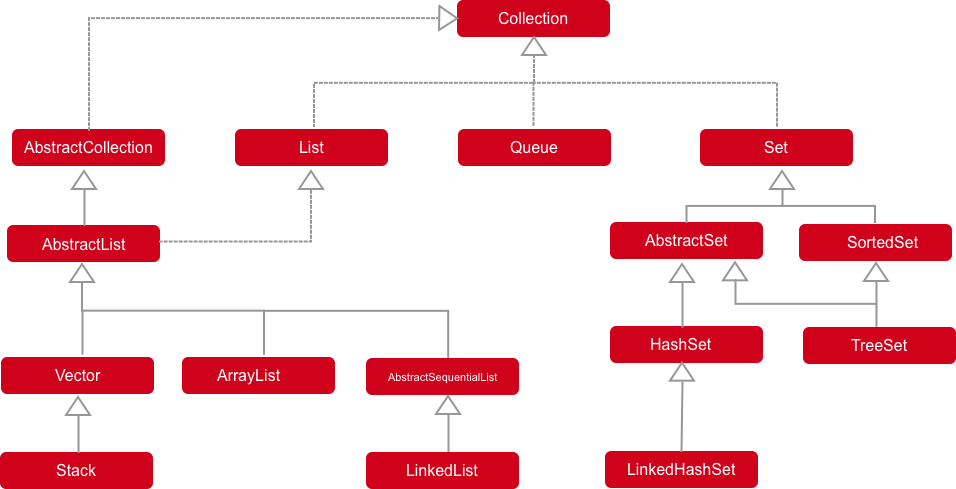Java中的工具类-集合
Java的集合框架主要有Joshua Bloch实现。
以行为分,集合类的拓扑结构

List,Set,Queue 接口之间的区别
List 接口的设计目的
-
是一个有序的集合。
有序体现在 每个集合中的元素都有一个索引(index) -
可精确控制List
[集合中]的元素,比如remove(), get(),全体迭代等。 -
可使用索引查找集合中的元素,或者全体检索。
Set的设计目的
| Set符合数学意上对结合的定义 {x | 1,2,3,..N } |
- 不包含重复元素。更具体的说, 集合内部不存在两个元素使得 x.hashcode == y.hashcode 为true。
Queue的设计目的
-
人如其名,它为队列的行为设计。在集合的基础上增加了 插入(insertion)、提取(extraction)、查看(inspections)操作。 -
每个方法都有两种形式。 操作失败则抛出异常,另一个方法放回特定值。
-
一般实现不允许null元素插入。
List的子类
ArrayList
- 自动扩容, 默认容量 10
使用Arrays.copyOf方法 按照固定大小生成一个新的array。
-
get,set, iterator, listIterator 运行效率为O(1)
-
insert 操作运行效率O(N)
-
所有操作没有使用同步方法(synchronized)
多线程场景下,创建方法
List list = Collections.synchronizedList(new ArrayList(…));
Vendor
-
自增长的数组
-
线程安全的数组操作。基本操作有synchronized修饰符。
-
子类Stack实现了LIFO(后进先出)的操作方式(线程安全) pop, push, peek, search 。
AbstractSequentialList及其子类LinkedList
-
双向链表,子类实现LinkedList实现没有线程安全
-
实现顺序访问(List),
顺序访问的含义是增删查操作 从头或者从尾部操作。
随机访问的列表,
随机表现在 在存储之前要先确定容量(分配内存),分配完成后,把数据存储在特定位置。 顺序访问通过指针地址链起来,不需要实现确定容量。
Set接口实现以及abstractSet及其子类
-
集合类最重要的行为是判断元素是否属于
当前集合 -
HashSet 类是HashMap的子视图。何为子视图? 它是的实现基于HashMap的key,原因是hashMap的key 实现了
去重、迭代器、常规增删查。 -
LinekdHashSet 是LinkedHashMap的子视图(设计模式中的
适配器模式)。 而普通的HashSet是HashMap的子视图。 -
允许空插入。是否允许
空插入为什么特别强调? 因为空是判断集合完整性的重要特征。 -
操作不是线程安全的。使用Collections类的包装器返回一个线程安全的实例:
Set s = Collections.synchronizedSet(new LinkedHashSet(…));
-
SortedSet 是支持排序的集合。
-
SortedSet 有四种构造形式: (1)、空构造器 (2)、携带一个比较器(实现Comparator接口)的构造器 (3) 以集合(Collection接口)子类为参数的构造。(4) 以自身类实例(SortedSet)为参数的构造。
-
TreeSet 的实现不是线程安全的。它把add、remove、contains操作的时间从原来的O(N)缩短为Log(n)。 类似hashSet, 它是适配完的TreeMap
-
以上可见, Set子类的实现依托于Map类的实现。 原因是Map类的keys是一个集合的实现。 Map的本质是通过hashcode把一类集合(键keys) 映射到 另外一类(值values)集合。
ArrayList、LinkedList的增、删效率比较
public static void main(String[] args) {
ArrayList arrayList = new ArrayList();
LinkedList linkedList = new LinkedList();
// ArrayList add
long startTime = System.nanoTime();
for (int i = 0; i < 100000; i++) {
arrayList.add(i);
}
long endTime = System.nanoTime();
long duration = endTime - startTime;
System.out.println("ArrayList add: " + duration);
// LinkedList add
startTime = System.nanoTime();
for (int i = 0; i < 100000; i++) {
linkedList.add(i);
}
endTime = System.nanoTime();
duration = endTime - startTime;
System.out.println("LinkedList add: " + duration);
// ArrayList get
startTime = System.nanoTime();
for (int i = 0; i < 10000; i++) {
arrayList.get(i);
}
endTime = System.nanoTime();
duration = endTime - startTime;
System.out.println("ArrayList get: " + duration);
// LinkedList get
startTime = System.nanoTime();
for (int i = 0; i < 10000; i++) {
linkedList.get(i);
}
endTime = System.nanoTime();
duration = endTime - startTime;
System.out.println("LinkedList get: " + duration);
// ArrayList remove
startTime = System.nanoTime();
for (int i = 9999; i >=0; i--) {
arrayList.remove(i);
}
endTime = System.nanoTime();
duration = endTime - startTime;
System.out.println("ArrayList remove: " + duration);
// LinkedList remove
startTime = System.nanoTime();
for (int i = 9999; i >=0; i--) {
linkedList.remove(i);
}
endTime = System.nanoTime();
duration = endTime - startTime;
System.out.println("LinkedList remove: " + duration);
}
运行时输出
ArrayList add: 47381357
LinkedList add: 6723342 # LinkedList 增加元素的效率大约是arraylist的7倍
ArrayList get: 33054261 # get的效率是linkedlist的9倍
LinkedList get: 376488900
ArrayList remove: 659588253
LinkedList remove: 185407357 # 删除效率是arrraylist的4倍
Process finished with exit code 0
为什么linkedlist的add、remove效率比arraylist高?
ArrayList的add方法定义
/**
* Appends the specified element to the end of this list.
*
* @param e element to be appended to this list
* @return <tt>true</tt> (as specified by {@link Collection#add})
*/
public boolean add(E e) {
ensureCapacityInternal(size + 1); // Increments modCount!!
elementData[size++] = e;
return true;
}
LinkedList的add方法定义
/**
* Appends the specified element to the end of this list.
*
* <p>This method is equivalent to {@link #addLast}.
*
* @param e element to be appended to this list
* @return {@code true} (as specified by {@link Collection#add})
*/
public boolean add(E e) {
linkLast(e);
return true;
}
/**
* Links e as last element.
*/
void linkLast(E e) {
final Node<E> l = last;
final Node<E> newNode = new Node<>(l, e, null);
last = newNode;
if (l == null)
first = newNode;
else
l.next = newNode;
size++;
modCount++;
}
从定义来看 arraylist的add方法比linkedlist多了一步容量检查。
LinkedList的remove操作定义
public boolean remove(Object o) {
if (o == null) {
for (Node<E> x = first; x != null; x = x.next) {
if (x.item == null) {
unlink(x);
return true;
}
}
} else {
for (Node<E> x = first; x != null; x = x.next) {
if (o.equals(x.item)) {
unlink(x);
return true;
}
}
}
return false;
}
ArrayList的remove操作定义
public E remove(int index) {
rangeCheck(index);
modCount++;
E oldValue = elementData(index);
int numMoved = size - index - 1;
if (numMoved > 0)
System.arraycopy(elementData, index+1, elementData, index,
numMoved);
elementData[--size] = null; // clear to let GC do its work
return oldValue;
}
ArrayList的remove定义效率更底了, 使用System.arraycopy直接把移除元素后面的元素整体迁移。 LinkedList的移除方法效率是O(N)